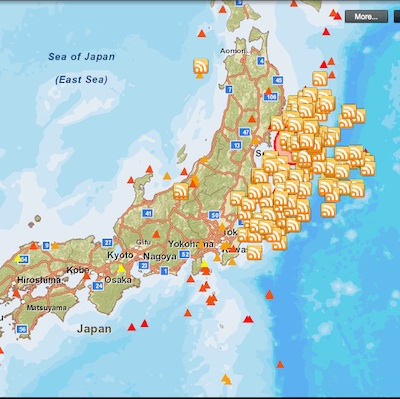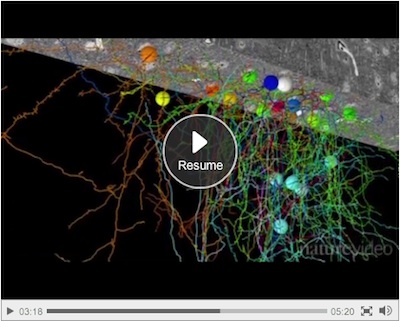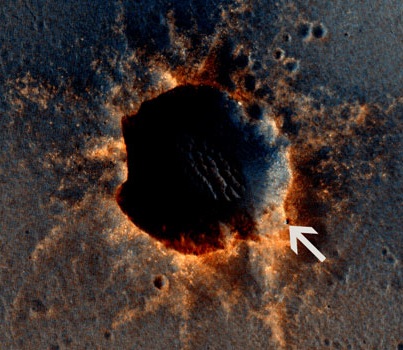View Japan quake aftershocks in near-real-time, watch the light show at Kilauea volcano, make a map of the brain, and interact with a Data-like android. All this and more in this week’s Science Saturday!
Near-Real-Time Map of Japan Quake Aftershocks
The 8.9 magnitude earthquake that struck Japan this week has continued to shake the country with aftershocks. Researchers at Texas Tech’s Center for Geospatial Technologies have created a near-real-time map of aftershock earthquakes, accessible on the web. The map was developed after scientists notices a lack of information being presented on major news outlets. “It provides map information, satellite imagery and location of recent earthquakes. As part of this major earthquake, there are hundreds of aftershocks that follow.”
See the earthquake map live at mapserver.gis.ttu.edu/japanquake/

See the live earthquake map
Mount Kilauea Living Up to its Fiery Reputation
Mount Kilauea in Hawaii, whose name means “spewing” or “spreading” in Hawaiian, is one of the most active volcanoes in the world and has been giving onlookers quite a show lately. Throughout January and February, it has been rumbling and crater walls have been collapsing. On 3 March, a dramatic collapse at Halema’uma’u shows part of the vent wall falling into the lava lake. Erupting fissures were filmed in early March, sending lava up to 10 meters into the air. According to US Geological Survey (USGS), a lake of lava about 200 meters deep has formed inside one of the craters, while seismic activity in the area remains high. New reports estimate that 150 detectable earthquakes have been caused by the eruption, although so far it poses no threat to locals. The time-lapse is a compilation of videos shot by the (USGS) from a variety of cameras between 15 February and 6 March 2011. (via New Scientist)
Untangling the Brain
Knowing how the tangle of billions of nerve cells in the brain are connected will be key to understanding how we see and dream — and how to repair the brain when something goes wrong. In a first step, scientists have mapped the wiring in part of the mouse brain and related it to how the animal sees. (via Guardian Science)
New Amazingly Life-like Android Better than Data?
Some are claiming that Geminoid DK, a new android built by the Intelligent Robotics lab at Osaka University and designed by professor Hiroshi Ishiguro, might be even more lifelike than Brent Spiner’s Data. Just like Data was modeled after his creator Doctor Noonian Soong, the Geminoid DK is created in the likeness of professor Henrik Scharfe of Aalborg University in Denmark. “All of the movements and expressions of Geminoid DK are remote controlled by an operator with a computer, who uses a motion-capture system that tracks facial expressions and head movements. Turn your head and the Geminoid does the same; move your mouth and the android follows suit,” IEEE Spectrum reports. (via Universe Today)
Pic of the Week: Opportunity at Santa Maria Crater
The High Resolution Imaging Science Experiment (HiRISE) camera on NASA’s Mars Reconnaissance Orbiter acquired this beautiful color image on March 9, 2011, of “Santa Maria” crater, showing NASA’s Mars Exploration Rover Opportunity perched on the southeast rim.
Science Bytes
Not enough science for you? Here’s a warp-speed look at some more science tid-bits that are worth a peek.
Near-Real-Time Map of Japan Quake Aftershocks
The 8.9 magnitude earthquake that struck Japan this week has continued to shake the country with aftershocks. Researchers at Texas Tech’s Center for Geospatial Technologies have created a near-real-time map of aftershock earthquakes, accessible on the web. The map was developed after scientists notices a lack of information being presented on major news outlets. “It provides map information, satellite imagery and location of recent earthquakes. As part of this major earthquake, there are hundreds of aftershocks that follow.”
See the earthquake map live at mapserver.gis.ttu.edu/japanquake/

See the live earthquake map
Mount Kilauea Living Up to its Fiery Reputation
Mount Kilauea in Hawaii, whose name means “spewing” or “spreading” in Hawaiian, is one of the most active volcanoes in the world and has been giving onlookers quite a show lately. Throughout January and February, it has been rumbling and crater walls have been collapsing. On 3 March, a dramatic collapse at Halema’uma’u shows part of the vent wall falling into the lava lake. Erupting fissures were filmed in early March, sending lava up to 10 meters into the air. According to US Geological Survey (USGS), a lake of lava about 200 meters deep has formed inside one of the craters, while seismic activity in the area remains high. New reports estimate that 150 detectable earthquakes have been caused by the eruption, although so far it poses no threat to locals. The time-lapse is a compilation of videos shot by the (USGS) from a variety of cameras between 15 February and 6 March 2011. (via New Scientist)
Untangling the Brain
Knowing how the tangle of billions of nerve cells in the brain are connected will be key to understanding how we see and dream — and how to repair the brain when something goes wrong. In a first step, scientists have mapped the wiring in part of the mouse brain and related it to how the animal sees. (via Guardian Science)
New Amazingly Life-like Android Better than Data?
Some are claiming that Geminoid DK, a new android built by the Intelligent Robotics lab at Osaka University and designed by professor Hiroshi Ishiguro, might be even more lifelike than Brent Spiner’s Data. Just like Data was modeled after his creator Doctor Noonian Soong, the Geminoid DK is created in the likeness of professor Henrik Scharfe of Aalborg University in Denmark. “All of the movements and expressions of Geminoid DK are remote controlled by an operator with a computer, who uses a motion-capture system that tracks facial expressions and head movements. Turn your head and the Geminoid does the same; move your mouth and the android follows suit,” IEEE Spectrum reports. (via Universe Today)
Pic of the Week: Opportunity at Santa Maria Crater
The High Resolution Imaging Science Experiment (HiRISE) camera on NASA’s Mars Reconnaissance Orbiter acquired this beautiful color image on March 9, 2011, of “Santa Maria” crater, showing NASA’s Mars Exploration Rover Opportunity perched on the southeast rim.
Science Bytes
Not enough science for you? Here’s a warp-speed look at some more science tid-bits that are worth a peek.
- The next mission to Mars soon to be decided, based on decadal-survey committee recommendations
- Half-Time for the Mars500


No comments:
Post a Comment